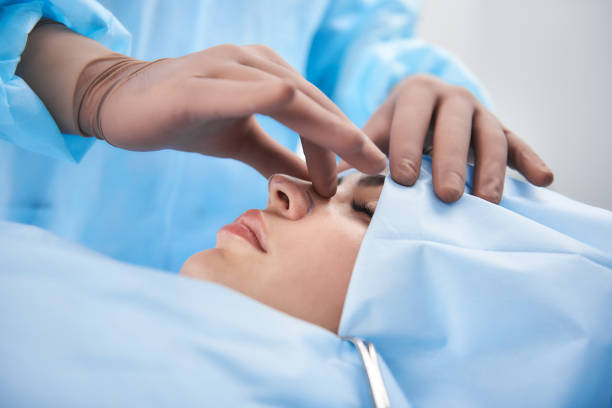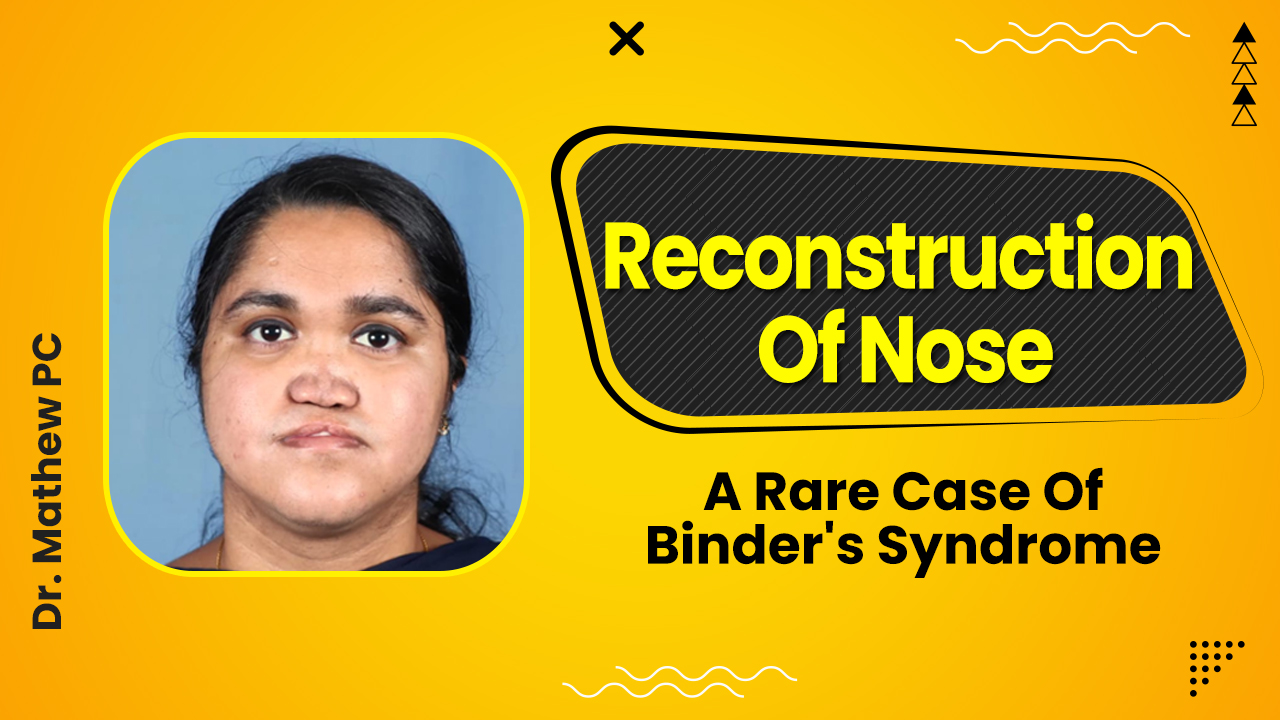Maxillonasal Dysplasia (Binder’s Syndrome): A Rare Genetic Disorder
Delve into Binder’s Syndrome—symptoms, causes, and treatments. Discover how Dr. Mathew PC’s expertise provides hope and solutions for affected individuals.

Do you know what maxillonasal dysplasia or Binder’s Syndrome is? It’s a rare genetic disorder that affects the nose and face. Unfortunately, there is no cure for it, but there are treatments available that can help improve the quality of life for those who have it. In this blog post, we will discuss all Binder’s syndrome, including symptoms, causes, and treatment options.
Our hospital, Dr Mathew PC and team provide the best treatment for this condition. Dr Mathew PC is the best rhinoplastic surgeon in Kerala, India with experience of more than 13 years and performs all types of Facial Cosmetic Surgery procedures such as Rhinoplasty, Face Lift etc. Our hospital provides the best rhinoplasty in India.

What Is Binder’s Syndrome?
Nasolabial hypoplasia, also known as Binder syndrome, is a rare congenital malformation of the face. The development of the central face and nose, as well as portions of the upper jaw, may be included in this condition.
Binder’s Syndrome (BS) is a rare and severe genetic disorder characterized by the absence of the anterior nasal spine that supports the nose in normal development. Your youngster may appear to have an undersized upper jaw and facial imbalance.
Facial trauma, such as that caused by a fall or dog attack, might result in Binder’s syndrome. Binder’s syndrome is an uncommon congenital condition that appears during the first trimester of pregnancy and has particular effects on facial features. The following deformities are present: arhinoid face (associated with malocclusion), intermaxillary hypoplasia (linked to tooth misalignment), nasal bone position abnormalities, nasal mucosa atrophy, anterior nasal spine agenesis, and (in most cases) a lack of frontal sinuses. Other anomalies, as well as mental retardation, are possible.
Patients with this condition usually need surgical and orthodontic therapy. Nasal reconstruction utilizing bone or cartilage transplants is the most common surgery in these patients. Due to graft resorption and an unattractive appearance, patients typically require more than one surgical procedure. Treatment for malocclusion is based on Class III treatment (pseudo-mesio-occlusion), which aims to relieve dental crowding. Malocclusion may necessitate combined orthodontic and surgical care.
Causes Of Binder’s Syndrome
The cause of Binder’s syndrome is still unknown, but it is believed to be a genetic disorder. Some possible causes include chromosomal abnormalities, mutations in certain genes, or environmental factors.
In many circumstances, the disease is considered to develop randomly (sporadically). There have been cases in the medical literature of families in which multiple family members were impacted. This implies that genetic factors might play a part in certain afflicted persons.
According to one theory, Binder type nasomaxillary dysplasia is a hereditary condition caused by an autosomal dominant or recessive inheritance. Other experts believe the disease is caused by complex genetic factors, such as the interaction of many different genres, as well as environmental conditions (multifactorial inheritance).

Symptoms Of Binder’s Syndrome
Binder’s syndrome is a rare genetic disorder that affects the nose and face. It can cause a wide range of symptoms, including a tiny nose, a small lower jaw, and a flat nasal bridge. People with Binder’s syndrome may also have difficulty breathing and swallowing. There is no cure for Binder’s syndrome, but treatment can help manage the symptoms.
If you or your child has any of these symptoms, it’s important to see a doctor for a diagnosis. Early diagnosis and treatment can help improve the long-term outlook. There is no cure for Binder’s syndrome, but treatments can help manage the symptoms and improve quality of life.
Patients with the most severe form of Binder’s syndrome have an underbite (malocclusion) and a tiny nose, owing to their prominent bony deficiency on either side of the nose. The alignment of the upper teeth in moderate cases may be acceptable, while only the bone deficit on either side of the nose distinguishes them from other individuals.
A shortened columella and an underdeveloped nasal bridge are hallmarks of the condition. The bony tissue at the base of the columella (anterior nasal spine) is absent in children with Binder syndrome, who usually have comma-shaped nostrils.
Diagnosis Of Binder Syndrome
The diagnosis of Binder’s syndrome is often difficult as it can mimic other disorders. The features of the syndrome can vary greatly from one individual to another. Some of the common signs and symptoms of Binder syndrome include a wide nasal bridge, a high-arched palate, a small lower jaw, and an underdeveloped nose.
Other symptoms may include vision problems, hearing loss, and intellectual disability. There is no specific test that can be used to diagnose Binder syndrome. The diagnosis is often made based on the patient’s medical history and a physical examination. A variety of tests can be used to verify the diagnosis, including X-rays and CT scans.
Treatment Of Binder’s Syndrome
There is no specific treatment for Binder’s syndrome. However, the symptoms of the condition can be managed with surgery and other treatments. Surgery is often required to improve the appearance of the face and to correct any functional problems.
The type of surgery required will depend on the individual features of the syndrome. In some cases, multiple surgeries may be necessary. Other treatments, such as speech therapy and occupational therapy, may also be recommended.
Treatment is typically focused on managing symptoms with surgery and other treatments. Surgery is often required to improve the appearance of the face and to correct any functional problems. The type of surgery required will depend on the individual features of the syndrome. In some cases, multiple surgeries may be necessary. Other treatments, such as speech therapy and occupational therapy, may also be recommended.
The therapy for Binder’s syndrome is personalized to the distinct symptoms that each patient experiences.
The treatment of an affected child might need the involvement of a team of specialists. Paediatricians or general internists, oral and plastic surgeons, craniofacial surgeons, orthodontists specializing in the diagnosis, prevention, and therapy of crooked teeth (orthodontists), orthopedists specializing in the diagnosis and treatment of disorders of the bones, joints, ligaments and muscles (orthopedists), and other healthcare professionals may need to collaborate to carefully plan an affect child’s therapy. Psychosocial assistance for both parents and siblings is also necessary.
There are no established treatment methods or standards for people with Binder syndrome. Because the illness is uncommon, no large-scale trials have been conducted to test different therapies on a large number of people. Various treatments have been reported in medical journals as part of single case reports or small series of patients. Treatment studies would be particularly advantageous in determining the long-term safety and efficacy of particular medicines and therapy options for persons with Binder syndrome.
Treatment options may include orthodontic and surgical procedures to assist repair faults in the jaw and nose. Each patient’s particular therapeutic choices will be determined by a variety of criteria, including the type and severity of his or her disease, as well as specific anatomical anomalies present.
More than one surgical treatment is often required. The specific sort and timing of each surgical operation are decided on the basis of the disease’s severity and the patient’s age. Some teens with fibrodysplasia ossificans were treated in childhood, whereas others were not treated until their late adolescent years when the bone growth had come to an end.
Treatment for Class III malocclusions might include a variety of methods. Braces, for example, may correct crooked teeth or reposition the jaw. The implantation of alloplastic materials to rebuild the nose (nasal) is another option. In certain situations, costochondral grafts have been utilized to restore the nose (costochondral graft).
A Le Fort I or II osteotomy is required in more severe situations. The upper jaw is broken and rearranged to treat malocclusion and, if present, cleft palate during a Le Fort I osteotomy. A Le Fort II osteotomy moves the upper jaw and nose while correcting the middle portion of the face’s backward displacement (retrusion).
Nasal deformities are typically treated by adding cartilage grafts to the bridge and supporting the tip in order to enhance projection and form. These may come from the ear, although most of the time additional cartilage is required as well. Treatment of limited nasal passageways may also be necessary.
Binder’s syndrome is a rare genetic disorder that affects the nose and face. The treatment plan for this disease will depend on how severe it is, but typically includes surgery and other treatments. In some cases, multiple surgeries may be necessary to help correct any functional problems or for cosmetic purposes (such as improving the appearance of the face). It can also include orthodontic procedures to reposition crooked teeth or braces if needed.
Psychosocial assistance should be offered as well because Binder’s syndrome can have an emotional impact on both parents and siblings alike. There are no established standards in treating patients with Binder Syndrome due to its relatively uncommon nature; more research into what therapies work best would provide invaluable insight into this condition so that we might better understand how to treat it.


